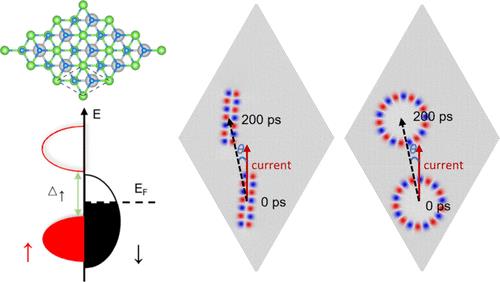二维磁体中的拓扑自旋结构,如斯格明子(skyrmions)、双麦纫(bimerons)等,因其独特的拓扑保护特性而备受关注。这种拓扑保护使得这些准粒子在面对外界扰动时能够保持稳定,有望在下一代信息存算技术中发挥重要作用。最近,我们受单层MoSi2N4启发,通过第一性原理预测了具有铁磁半金属性质和强面内磁各向异性的单层GdA2N4(A = Ge,Sn)。这些基于稀土元素的二维磁体中存在由磁阻挫引起的双麦韧团簇,且可通过应变工程进行调控。通过二维铁磁半金属中100%自旋极化电流,我们实现双麦韧团簇的的高效定向驱动。该工作为基于二维半金属材料中拓扑磁结构的信息计算和存储器件设计提供了理论指导。
Topological spin structures in two-dimensional magnets, such as skyrmions and bimerons, have attracted significant attention due to their unique topologically protected properties. This topological protection enables these quasiparticles to remain stable in the face of external disturbances, holding great promise for playing important roles in next-generation information storage and computing technologies. Recently, inspired by monolayer MoSi2N4, we predicted through first-principles calculations that monolayer GdA2N4(A = Ge,Sn) possesses ferromagnetic half-metallic properties and strong in-plane magnetic anisotropy. In these two-dimensional magnets based on rare-earth elements, bimeron clusters induced by magnetic frustration exist and can be regulated by strain engineering. We achieved efficient directional driving of bimeron clusters using 100% spin-polarized current in the two-dimensional ferromagnetic half-metal. This work provides theoretical guidance for the design of information computing and storage devices based on topological magnetic structures in two-dimensional half-metallic materials.

图1 GdGe2N4中半金属性态密度示意图及其中不同类型双麦韧磁结构的100%自旋极化电流驱动
相关成果已经发表于《纳米快报》(Nano Letters 24,15473–15480(2024)),论文第一作者为博士研究生刘玮其。论文链接:https://pubs.acs.org/doi/10.1021/acs.nanolett.4c05268

 ENGLISH
ENGLISH


